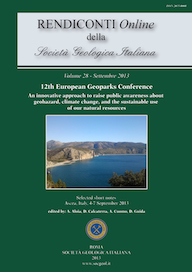
Geoheritage and history of gold digging in Ivalojoki River valley, northern Finland
Peter Johansson (*), Kauko Launonen (**), Inkeri Syrjänen (**) & Janne Seurujärvi (***)
(*) Geological Survey of Finland, P.O. Box 77, FIN-96101 Rovaniemi, Finland. E-mail: peter.johansson@gtk.fi
(**) Gold Prospector Museum, Tankavaarantie 11 C, FIN-99695 Tankavaara, Finland.
(***) Inari Municipal Economic Development Company InLike Ltd. Sairaalantie 3 b, FIN-99800 Ivalo, Finland.
Volume: 28/2013
Pages: 88-92
Abstract
The Ivalojoki river in northern Finland flows in an ancient preglacial valley. It stretches 180 kilometers through wilderness areas towards the Barents Sea. The area is famous for its natural Arctic landscape, placer gold deposits and historical sites related to gold prospecting. The Precambrian granulite bedrock was formed about 1,900 million years ago. Gold in the bedrock formed gradually over a course of millions of years. During the Ice Ages glaciers carved and eroded the rock. The most common glacial deposit, basal till, contains gold grains loosened from the bedrock. The glacier melted around 10,500 years ago. During deglaciation, melt water played a significant part in enriching the gravel deposits along the shores and in the channels of the river Ivalojoki and its tributaries, with gold nuggets from till. They are the result of being repeatedly eroded, transported and deposited as placers by the flowing water. The gold history of Finnish Lapland begins with the Ivalojoki river in 1868, when the first discoveries of gold nuggets were made there. It led to a great gold rush amid the uninhabited wilderness. The great gold rush came to end within a few years, but the unprofessional panning for gold in the area still continues today.
Keywords
Get Full Text